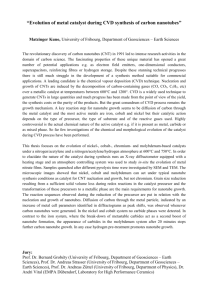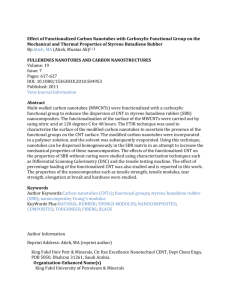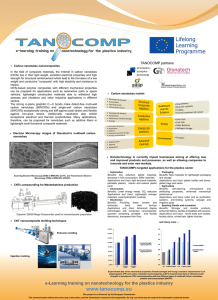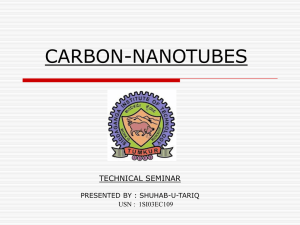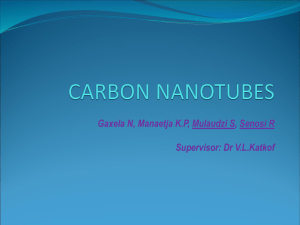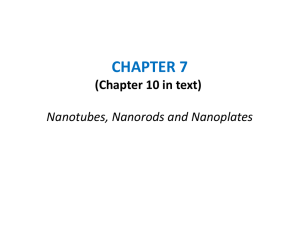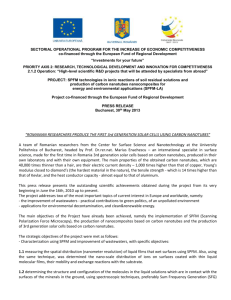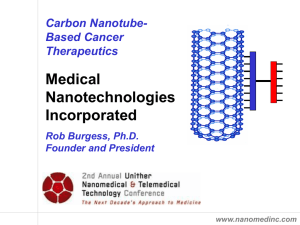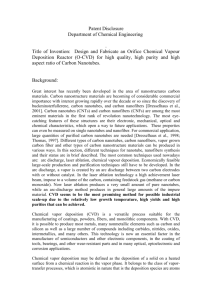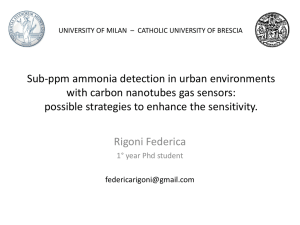Carbon Nanotube Synthesis – Presentation Here
advertisement
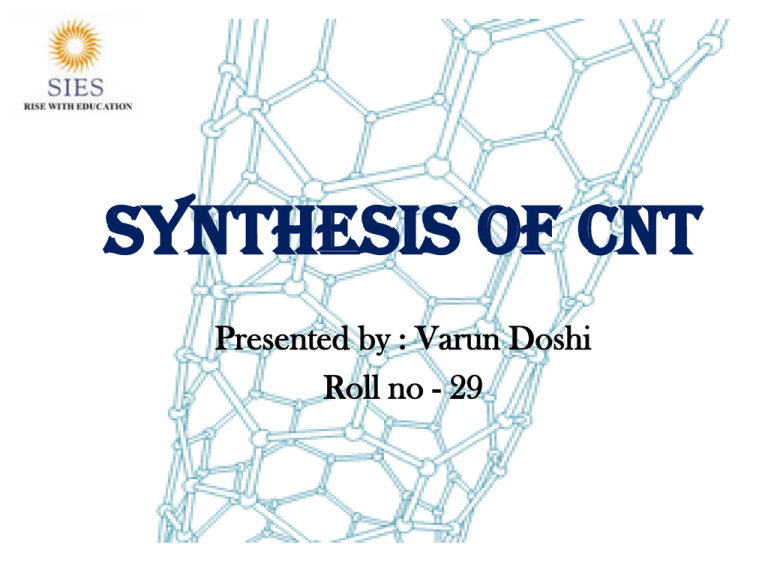
Synthesis of CNT Presented by : Varun Doshi Roll no - 29 What is Nanotechnology? • Nanotechnology is the ability to control or manipulate materials on the atomic scale to create structures that have novel properties and functions because of their size, shape or composition. • These structures are typically less than 100 nanometers in size. Understanding the Nanodimension What Are Carbon Nanotubes? • CNT can be described as a sheet of graphite rolled into a cylinder • Constructed from hexagonal rings of carbon • Can have one layer or multiple layers • Can have caps at the ends making them look like pills Carbon nanotube properties One dimensional sheets of hexagonal network of carbon rolled to form tubes ~1 nm in diameter & can be microns long in length Varieties include single-wall and multi-wall nanotubes, ropes, bundles, arrays Strongest and stiffest materials yet discovered in terms of tensile strength and elastic modulus Multi-walled nanotubes exhibit a striking telescoping property whereby an inner nanotube core may slide, almost without friction, within its outer nanotube shell thus creating an atomically perfect linear or rotational bearing CNT properTies …CONTD • All nanotubes are expected to be very good thermal conductors along the tube, exhibiting a property known as "ballistic conduction," but good insulators laterally to the tube axis. • Multiwalled carbon nanotubes with interconnected inner shells show superconductivity with a relatively high transition temperature Methods of synthesis of CNT • Arc discharge • Laser ablation • Chemical vapor deposition (CVD) Arc Discharge • Nanotubes were initially discovered using this technique so it is the most widely-used method of nanotube synthesis • Carbon contained in the negative electrode sublimates because of the high discharge temperatures forming Nanotubes • Yield for this method is up to 30 percent by weight • Produces both single- and multi-walled nanotubes with lengths of up to 50 micrometers with few structural defects Diagrammatic representation of Arc Discharge Laser ablation • Developed by Dr. Richard Smalley and co-workers at Rice University • Pulsed laser vaporizes a graphite target in a high-temperature reactor which has inert gas • Nanotubes develop on the cooler surfaces of the reactor as the vaporized carbon condenses • Water-cooled surface may be included in the system to collect the nanotubes • The laser ablation method yields around 70% and • Produces primarily single-walled carbon nanotubes with a controllable diameter determined by the reaction temperature • More expensive than either arc discharge or chemical vapor deposition Diagrammatic representation of Laser ablation Chemical vapor deposition (CVD) • Commercial method for production of carbon nanotubes • Substrate is prepared with a layer of metal catalyst particles(commonly nickel, cobalt, iron, or a combination) • Diameters of the nanotubes depends on the size of the metal particles • Two gases are bled into the reactor: – a process gas (such as ammonia, nitrogen or hydrogen) and – a carbon-containing gas (such as acetylene, ethylene, ethanol or methane) • This can be controlled by patterned (or masked) deposition of the metal, annealing, or by plasma etching of a metal layer • Substrate is now heated to ~ 700°C which initiate the growth of nanotubes CVD . . . contd • Nanotubes grow at the sites of the metal catalyst; the carboncontaining gas is broken apart at the surface of the catalyst particle, and the carbon is transported to the edges of the particle, where it forms the nanotubes. • Catalyst particles can stay at the tips of the growing nanotube during the growth process, or remain at the nanotube base, depending on the adhesion between the catalyst particle and the substrate • One issue in this synthesis route is the removal of the catalyst support via an acid treatment, which sometimes could destroy the original structure of the carbon nanotubes. However, alternative catalyst supports that are soluble in water have proven effective for nanotube growth Diagrammatic representation of CVD CNT application in nanomedicine • Multipurpose innovative carriers for drug delivery and diagnostic applications • Biosensors, composite materials, molecular electronics • Delivery of drugs, antigens and genes • Functionalized CNTs with high solubility and low toxicity as drug carriers • High loading capacity of drug in double functionalized carbon nanotube Bibliography • Available at URL: http://www.fy.chalmers.se/atom/research/nanotubes/experimental.xml • Available at URL: http://ipn2.epfl.ch/CHBU/NTproduction2.htm • Available at URL: http://www.ifwdresden.de/institutes/iff/research/Cabon/CNT/laser-ablation • Available at URL: http://www.fy.chalmers.se/atom/research/nanotubes/experimental.xml


